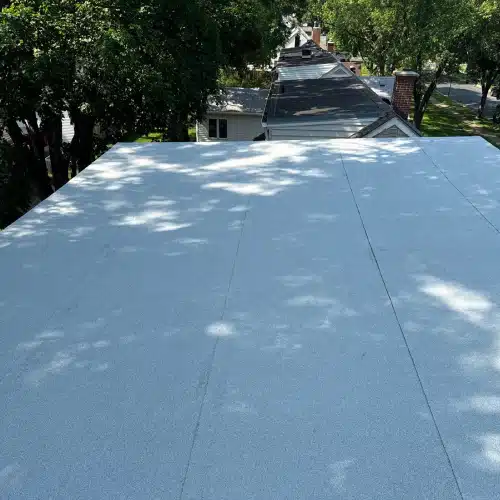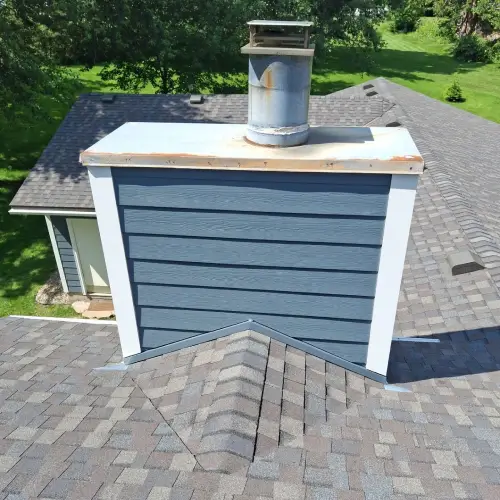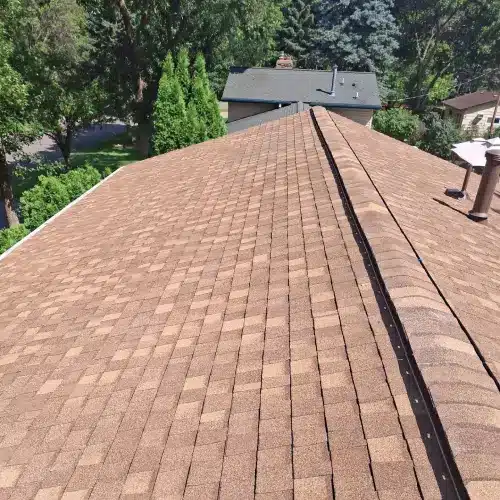Quick Summary
Whether you’re replacing shingles or comparing flat roofing systems, this guide breaks down the roofing terms Minnesota homeowners need to know. Understanding the basics helps you make confident decisions and communicate clearly with your contractor.
At Wright at Home Roofing & Exteriors, we are here to make that process simple. From defining the details to handling full roof replacements across the Minneapolis metro area.
Why Knowing Roofing Terms Matters
Q: Why should Minnesota homeowners learn basic roofing terms?
A: Knowing roofing terms helps Minnesota homeowners understand their estimates, spot important details during inspections, and ask better questions about materials or repairs. It builds confidence and ensures you and your contractor, like Wright at Home Roofing & Exteriors, stay on the same page from start to finish.
If you’ve ever looked at a roofing estimate and thought, “What’s flashing?” or “What does decking mean?” you’re not alone. Roofing comes with its own language, and when you understand it, you can ask better questions and make smarter choices about your home.
In Minnesota, that knowledge matters even more. Our roofs face everything from heavy snow to hailstorms, so every layer and component serves a purpose. Below, the experts at Wright at Home Roofing & Exteriors explain the most common roofing terms in plain language you can actually use.
Flat & Low-Slope Roofing Systems in Minnesota
Q: What is a low-slope roof, and how does it work in Minnesota?
A: A low-slope roof has a gentle pitch that drains water slowly, so it relies on waterproof materials like single-ply membranes or built-up roofing. In Minnesota, these systems protect flat roofs on additions and commercial buildings from snow, standing water, and freeze-thaw cycles.
Not all roofs in Minnesota have steep pitches. Flat and low-slope roofs are common on commercial buildings and home additions, where the roof has very little angle. Because water doesn’t run off as easily, these systems rely on specialized materials to drain efficiently and prevent leaks.
- Single-ply membrane roofing: A flexible, waterproof sheet made of EPDM, TPO, or PVC. It’s common across Minneapolis for its durability and low maintenance.
- PVC flat roofing: A single-ply option known for energy efficiency and long life—perfect for PVC flat roofing in Minneapolis, MN, where temperature swings are common.
- Built-up roofing systems (BUR): Multiple layers of bitumen and reinforcing fabric that create a strong, waterproof surface, often finished with gravel.
- Ballasted roofing systems: These use stones or pavers to hold the roof membrane in place, protecting it from wind and sunlight.
- Cant strips: Small angled pieces of wood or fiberboard that smooth the transition where a flat roof meets a wall or vertical surface.
- Soil pipe collar: The flashing ring that seals around plumbing vent pipes to prevent leaks.
- Concealed nail method: A technique where nails are hidden under overlapping materials for a clean, watertight finish.
- Selvage edge roofing: The finished edge on roll roofing that allows one piece to overlap another and seal tightly.
- Double coverage roll roofing: Two overlapping layers of roll roofing to increase protection from water.
Tip for Homeowners: If your home has a flat or low-slope section, like over a porch or addition, ask your roofer about single-ply or BUR systems. They’re designed to handle standing water better than traditional shingles.
Common Minnesota Residential Roof Components
Your roof is made up of several key components that work together to keep your home protected and ventilated. Here are some of the most common parts found on Minnesota homes.
- Drip edge: Also called edge flashing, this metal strip stops water from getting between your fascia and roofing system and keeps it off your fascia boards.
- Apron flashing: A metal strip placed behind gutters to stop water from dripping between the gutter and fascia.
- Shingles: The top protective layer of your roof and the first line of defense against Minnesota’s weather. Asphalt shingles remain the most popular option for their mix of durability, value, and curb appeal, and our team often recommends CertainTeed Landmark® shingles for long-lasting performance.
- Fascia and soffit: Fascia caps the edge of the roof; soffit is the vented underside of your eaves. Together, they protect rafters and allow airflow.
- Cornice: Decorative molding that projects from the top of the wall, forming the overhang.
- Eyebrow (vapor shed eyebrow): A small curved extension above a window or door that sheds rain and adds charm.
- Gable cornice: The triangular section at the end of a gable roof, often where decorative details are added.
- Roof projecting edge: The part of the roof that extends beyond the wall, directing water away from the siding.
- Ridge vent: The vent that runs along the roof’s peak, allowing warm, moist air to escape from the attic.
Where You’ll See It: During a roof replacement, your contractor may mention ridge vents, soffits, and drip edge together; they all work as part of your home’s ventilation and moisture control system.
Roofing Materials & Accessories Built for Minnesota Weather
Q: What roofing materials work best for Minnesota’s climate?
A: The best roofing materials for Minnesota are asphalt shingles, single-ply membranes, and metal flashing systems. These materials stand up to heavy snow, hail, and temperature swings—keeping homes durable, watertight, and energy-efficient all year long.
Minnesota’s seasons demand materials that can handle freezing winters and summer heat.
- Asphalt shingles: Many homeowners we work with throughout the Twin Cities—places like Plymouth, Maple Grove, and Bloomington—choose asphalt shingles for their dependable performance and value.
- Hot roofing tar: The heated adhesive used to bind layers in built-up roofing systems.
- Fiberglass mineral-surfaced roll roofing: A budget-friendly option for sheds or flat roofs.
- All-weather roofing compound: A sealant that remains flexible through extreme temperature shifts.
- Bitumen: The sticky black waterproofing material in many flat roof systems.
- Coal slag roofing granules: The coarse surface on shingles or flat roofs that improves traction and UV protection.
- Asbestos mastic sealer: An older product once used for sealing; today, safer alternatives are standard.
- Wood fiber insulation: A rigid insulation board made from wood fibers that helps regulate roof temperature.
- Bitumen boil-over: Overflow that can occur when heating or applying bitumen.
- Ballast broom: A tool used to spread gravel evenly on ballasted roofs.
- Polyester and polypropylene reinforced felt: Synthetic layers that strengthen and protect roof membranes from tearing.
Installation & Inspection Terms Explained
Q: What are the most important roofing installation terms for Minnesota homeowners?
A: Key roofing installation terms include decking (the wood base under your roof), flashing (metal that directs water away), and dry-in (a temporary waterproofing layer). Knowing these terms helps Minnesota homeowners read estimates clearly and understand every step of their roof replacement.
Understanding installation language helps you interpret your roofer’s estimate with confidence.
- Decking or Sheathing: The plywood or OSB base that supports the roof system.
- Dry-in: The process of temporarily waterproofing a roof with underlayment before shingles go on.
- Flashing: Thin metal pieces that redirect water around joints, chimneys, and valleys.
- Rafters: The structural beams that give your roof shape and strength.
- Nailing methods: Different patterns are used to secure shingles properly.
- Roof curing: The period when adhesives or coatings harden and become fully weatherproof.
Common Roofing FAQs Minnesota Homeowners Ask
What’s the metal edge of a roof called?
The metal edge of a roof is called the drip edge, which channels water into gutters instead of behind them, which can cause water to seep into the fascia or decking. A must-have detail for Minnesota’s wet and snowy seasons.
How do cant strips help in flat roof systems?
Cant strips are small, angled pieces of wood or fiberboard placed where a flat roof meets a wall. They smooth the transition where flat and vertical surfaces meet, preventing cracks or leaks in the roofing membrane.
What’s installed over a roof membrane to prevent wind uplift?
Roofers use ballast, usually gravel or pavers, to help weigh down the roofing system in place. It helps protect against wind uplift and UV damage, which can be harsh during Minnesota’s seasonal storms and temperature swings.
What’s the difference between BUR and single-ply systems?
BUR (Built-Up Roofing) systems use multiple layers of bitumen and fabric for strength, while single-ply systems rely on one strong, flexible sheet such as TPO or PVC. Both are reliable options for Minnesota flat roofs when properly installed and maintained.
What does “dry-in” mean?
It means the roof is temporarily sealed so rain or snow can’t enter before shingles or final materials are added.
What’s the purpose of a ridge vent?
A ridge vent runs along the peak of your roof to release hot, humid air from your attic to improve ventilation, help prevent mold growth, and extend the life of your roofing materials.
Ready to Learn More About Your Roof?
Q: Who should Minnesota homeowners call for roofing help?
A: Minnesota homeowners can call our expert team at Wright at Home Roofing & Exteriors for expert roof inspections, repairs, and replacements. As a trusted local contractor, our team explains every term, material, and recommendation clearly—so you feel confident your home is protected The Wright Way.
Now that you know the basics, reading an estimate or inspection report will feel a lot less intimidating. And if something still sounds confusing, that’s where we come in.
Contact Wright at Home Roofing & Exteriors to schedule an inspection or get a free quote. Our team proudly serves homeowners across the Minneapolis metro—and we’re always happy to explain every term and detail along the way.












